How Do Fashion Designers Make Clothes
- Clothing Patterns 101
- Elements of Design
Basic Elements of Article of clothing Pattern
If you've e'er wanted to dabble in vesture design simply thought y'all didn't have the skill or the talent, I'm here to tell you:
You can exercise information technology!
If y'all sew your own clothes from commercial patterns you buy at the cloth store,you already brand design decisions regarding mode, color, fabric, and details.You make similar decisions when you shop, choosing the styles that have the details yous desire (that is, if you tin can detect them!)
Yous can design your ain wearing apparel using the same style sense you utilize when yous sew together or when you lot shop - and y'all accept full control over the results!
Elements of Design
The design details yous'd utilise to distinguish your manner include;
- the shape of the neck and/or collar
- the length, shape and fullness of sleeves (with or without cuffs)
- the shape, length, and fullness of a skirt
- the length, shape and fullness of a top or blouse.
By combining these elements in a "mix and match" fashion, you'll create an endless variety of styles - try a shawl collar with short sleeves, or bell sleeves and a V-neck top. These are simple variations on a basic blouse or meridian!
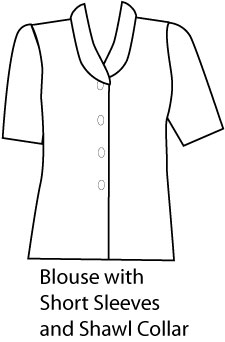
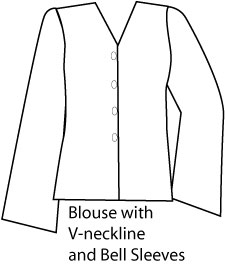
Darts and shaping seams tin can also be used as design elements – princess seams and shoulder or hip yokes are normally used design details that as well give the garment shape and fit.
Pleats and gathers add fullness and movement. A slim cutting skims the body and is more tailored. By "mixing and matching" various pattern elements, you can come up with an nigh endless array of styles.
Ease is the corporeality of extra textile immune for move and/or style in a garment.Fitting ease (wearing ease) is the minimum amount of room needed for comfort and movement, usually 1 – one ½" more than than the body measurement.Style ease (design ease) is boosted ease added to achieve the desired style (such as a full brim or a full sleeve, or an oversized silhouette).
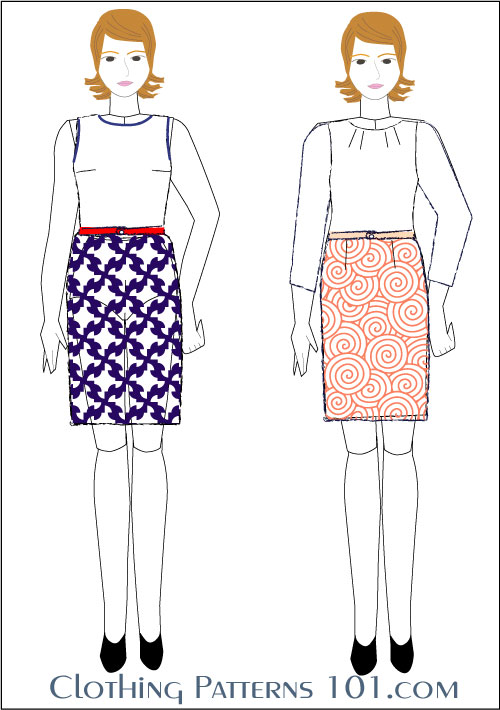
Even the most basic dress tin accept a variety of looks, depending upon the style details you choose.
For example, both of the dresses at left accept the same silhouette - uncomplicated, fitted styles with a natural waistline.
Just thedifferent colors, prints, and position of the bodice darts (side darts vs. neck darts) help create two entirely different looks. One has sleeves, one is sleeveless with contrast bounden - you could add or remove sleeves on either dress for still another new look.
Add flared skirts, total sleeves, or collars and you have an countless variety of fashions.
Shorten the trunk into a collection of tops and blouses and pair with skirts or pants - even more fashion options!
Simple elements, grouped together in varying combinations, are what clothing design is all about.
Finding Your Inspiration
To find inspiration for your designs, expect to the past, to other cultures, or just to the latest style magazines.
Don't copy directly from another designer, especially if you plan on selling your creations. But focus on a item that you love, and incorporate that into your pattern. It can be something as simple equally the shape of a neckline, the drape of the bodice, the flare of the skirt - anything that catches your center (information technology'southward jump to catch everyone else'due south centre in your garment, likewise!).
I love celebrated costume, only following a garment from the past feels too "costume-y" to me. I'll use the sleeve and neckline, or shape of the brim, as inspiration for my own design.
I also love ethnic wearable, but once more, want to avoid looking like I'thousand wearing a costume. Stitching or other decorative details tin easily be incorporated into a simple top or clothes.
For example, this is a 1920'due south two-piece wearing apparel that inspires me. I similar the wide cervix and tapered sleeves, but I especially similar the pleats at the left side and the depression-slung belt.

This is a kurta, which is a traditional men'southward tunic from India. It has a stand collar and regular shirt sleeves, but it too has the side pleats I like - and the asymmetrical hem is very modern.
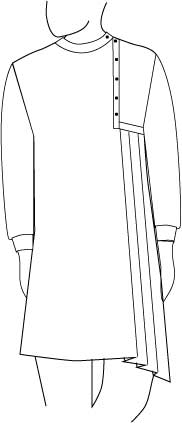
Using the 2 styles above, I created 2 unlike tunics utilizing elements from BOTH styles.
The one on the left refers generally to the men'due south kurta, just has the more feminine neckline and tapered sleeves taken from the 1920's dress.
The one on the right references the dress, information technology'due south been shortened to tunic length with the asymmetrical hem of the kurta. This necessitates raising the chugalug to the high hip, too.
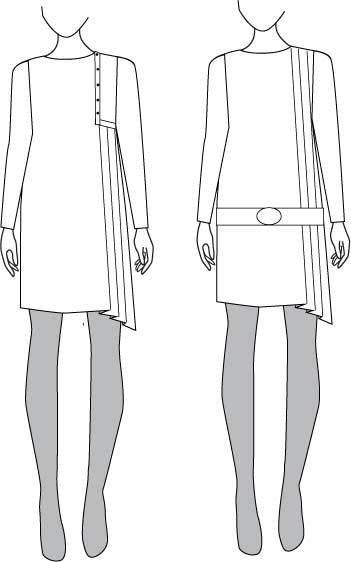
Neither of the tunics I designed are copies, but both retain elements from the historic and ethnic originals.
How to Get Started
And then, how to yous start designing your own dress?
Just offset sketching! Browse through magazines, make a quick sketch when you come across a celebrity wearing something you beloved, or make a note of a item equally you're watching a Telly show or movie.
So start putting those details together into a garment!
There volition exist a lot of trial and error - some blueprint elements work well together, some don't - and don't try to put ALL your favorite details into one garment. It'due south overwhelming and you'll lose focus.
But all you take to do is sketch, sketch, sketch - continue trying different combinations until you find what you lot really similar.
To help with your sketches, I accept developed a sketch book, with figure templates (chosen "croquis") that volition brand information technology much easier to draw your styles with proper proportion, and depict motility. Creating a realistic sketch of your idea will assist you lot visualize the fashion more fully.
The sketch book is available with misses or plus size croquis, and in a full-sheet size (eight 1/ii" x 11") or a smaller, purse size book
.
Click on the images, below, to go to the particular in Amazon.As an Amazon Associate I earn from qualifying purchases. This helps to keep this site free for your utilise. You are gratuitous to search Amazon for these or other similar items without using the chapter links on this page.


Pocket-sized Book

Small Book

And add colour!! Color tin can brand or pause a design. And achange of color - or color combinations -can create a whole new look for the same silhouette!
How can you get a grip on color? With coloring books! (yes, REALLY!!).
These way-inspired books, below, are a great start. Just grab some color pencils and go! It'southward but paper. You lot tin't make a mistake! Endeavor combinations that you recollect you'd never really wear. You'll exist surprised at what works and what doesn't - and how much difference a change of color tin can brand to any garment.
Click on the images, beneath, to go to the item in Amazon.Every bit an Amazon Acquaintance I earn from qualifying purchases. This helps to go along this site costless for your use. You are complimentary to search Amazon for these or other similar items without using the affiliate links on this page.
What's the Side by side Stride?
Pace-past-Step: Making and Fitting Your Block
- Brand Dress that Fit Yous Perfectly
- Using Plumbing fixtures Patterns
- A Beginner'south Guide to Drafting a Dress Block
- Fitting the Bodice Pattern
- Full Bust Adjustment
- Plumbing fixtures the Sleeve Pattern
- Fitting the Skirt Pattern
- Making Your Personal Pattern Block
- Making a Women'due south Blouse Block
- Plumbing equipment the Pants - Initial Fitting
- Plumbing equipment the Pants - Terminal Fitting
- A Beginner's Guide to Drafting a Pant Block
- The Importance of Sewing Darts
- Pattern Grading
Render to Clothing Patterns 101 Home Page
0 Response to "How Do Fashion Designers Make Clothes"
Post a Comment